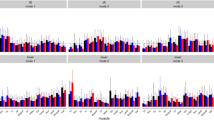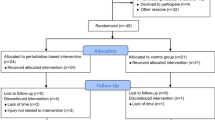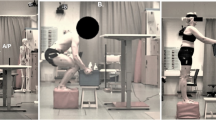Abstract
The study compares free and isokinetic lifing using a multivariate statistical analysis. Each of the 13 male subjects performed three free lifts and three isokinetic lifts using a CYBEX LIFTASK. The measurement variables were obtained from a 3D video system, two force lates and two strain-gauge transducers. Coupling of fuzzy space-time windowing and multiple correspondence analysis was used to show the links between the variables and the differences between the experimental situations. Isokinetic lifting had almost no points in common with free-lifting, but there was a similar range of extension for the different joints. Most free-lifting strategies could not be used in isokinetic lifting, as constraints between the subject and his environment were different. The main drawback of the isokinetic lifting was due to the necessity for individuals to reach the machine speed, yielding high transient efforts. The maximum vertical effort at the L5/S1 joint was about 1600, 1500 and 1400 N for low, medium and high speed, whereas it was lower than 1300 N, irrespective of the load, during free lifting. In the context of chronic low back pain rehabilitation, movement strategies used in free lifting could not be relearnt using an isokinetic machine. A better understanding of the common points and differences between isokinetic movement and free movement could help rehabilitation physicians to plan rehabilitation programmes, taking advantage of each kind of movement.
Similar content being viewed by others
References
Aleshinsky, S. Y. (1986a): ‘An energy source and fractions approach to the mechanical energy expenditure problem. I: Basic concepts, descriptions of the model, analysis of a one link system movement’,J. Biomech.,19, pp. 287–293
Aleshinsky, S. Y. (1986b): ‘An energy source and fractions approach to the mechanical energy expenditure problem. II: Movement of the multi-link chain model’,J. Biomech.,19, pp. 295–300
Aleshinsky, S. Y. (1986c): ‘An energy source and fractions approach to the mechanical energy expenditure problem. III: Mechanical energy expenditure reduction during one link movement’,J. Biomech.,19, pp. 301–306
Aleshinsky, S. Y. (1986d): ‘An energy source and fractions approach to the mechanical energy expenditure problem. IV Criticism of the concept of energy transfers within and between links’,J. Biomech.,19, pp. 307–309
Aleshinsky, S. Y. (1986e): ‘An energy source and fractions approach to the mechanical energy expenditure problem. V: The mechanical energy expenditure reduction during motion of the multi-link system’,J. Biomech.,19, pp. 311–315
Authier, M., Lortie, M., andGagnon, M. (1996): ‘Manual handling techniques: Comparing novices and experts’,Int. J. Industr. Ergonom.,17, pp. 419–429
Badler, N. I., Phillips, C. B., andWebber, B. L. (1993): ‘Simulating humans, computer graphics animation and control’ (Oxford University Press, New York, 1993)
Benzecri, I. P. (1992): ‘Correspondence analysis handbook’ (Marcel Dekker, New York, 1992)
Bouilland, S. (1997): ‘Etude biomécanique des levers de charge isocinétique et naturel—Application à la rééducation des lombalgiques chroniques’. PhD thesis 97-08, University of Valenciennes, France
Bouisset, S., andMaton, B. (1996): ‘Muscles, posture et mouvement, bases et applications de la méthode electromyographique’ (Hermann, Paris, 1996)
Burgess-Limerick, R., Abernathy, B., andNeal, R. (1993): ‘Relative phase quantifies interjoint coordination’,J. Biomech.,26, pp. 91–94
Burgess-Limerick, R., Abernathy, B., Neal, R., andKippers, V. (1995): ‘Self-selected manual lifting technique: functional consequence of the interjoint coordination’,Hum. Factors,37, pp. 395–411
Buseck, M., Schipplein, O. D., Anderson, G. B. J., andAndriacchi, T. P. (1988): ‘Influence of dynamic factors and external loads on the moment at the lumbar spine in lifting’,Spine,13, pp. 918–921
Cloup, P., Angué, J. C., andLaassel, E. M. (1988): ‘A new system of gestual automatic 3-D analysis’. 12th Annual Meeting of American Society of Biomechanics, University of Ilinois, Champaign. Sept. 1988
De Looze, M. P., Kingma, I., Bussman, J. B. J., andToussaint, H. M. (1992): ‘Validation of a dynamic linked segment model to calculate joint moment in lifting’,Clin. Biomech.,7, pp. 161–169
De Looze, M. P., Toussaint, H. M., Van Dieèen, J. H., andKemper, H. C. G. (1993): ‘Joint moments and muscle activity in the lower extremities and lower back in lifting and lowering tasks’,J. Biomech.,26, pp. 1067–1076
De Looze, M. P., Kingma, I., Thunnissen, W., Van Wijk, M. J., andToussaint, H. M. (1994): ‘The evaluation of a practical biomechanical model estimating lumbar moments in occupational activities’,Ergonomics,37, pp. 1495–1502
Estlander, A. M. andMellin, G. (1991): ‘Effects and follow-up of a multimodal treatment program including intensive physical training for low back pain patients’,Scand. J. Rehab. Med.,23, pp. 97–102
Freivalds, A., Chaffin, D., Garg, A., andLee, K. (1984): ‘A dynamic biomechanical evaluation of lifting maximum acceptable loads’,J. Biomech.,17, pp. 251–262
Gagnon, M., andSmyth, G. (1991): ‘Muscular mechanical energy expenditure as a process for detecting potential risks in manual materials handling’,J. Biomech.,24, pp. 191–203
Gagnon, D., andGagnon, M. (1992): ‘The influence of dynamic factors on triaxial net muscular moments at the L5/S1 joint during asymetrical lifting and lowering’,J. Biomech.,25, pp. 891–901
Gallagher, S., andHamrick, C. A. (1994): ‘Dynamic biomechanical modelling of symmetric and asymmetric lifting tasks in restricted postures’,Ergonomics,37, pp. 1289–1310
Garg, A., andBeller, D. (1994): ‘A comparison of isokinetic lifting strength with static strength and maximum acceptable weight with special reference to speed of lifting’,Ergonomics, 37, pp. 1363–1374
Hagen, K. B., Orhagen, O. S., andHarms-Rindahl, K. (1995): ‘Influence of weight and frequency on thigh and lower-trunk motion during repetitive lifting employing stoop and squat techniques’,Clin. Biomech.,10, pp. 122–127
Hazard, R., Reid, S., Fenwick, J., andReeves, V. (1988): ‘Isokinetic trunk and lifting strength measurements: Variability as an indicator of effort’,Spine,13, pp. 54–57
Kishino, N. D., Mayer, T. G., andGatchel, R. J. (1985): ‘Quantification of lumbar function: 4 Isometric and isokinetic lifting simulation in normal subjects and low back dysfunction patients’,Spine,10, pp. 921–927
Kromodihardjo, S., andMital, A. (1987): ‘Biomechanical analysis of manual lifting task’,J. Biomech. Eng.,109, pp. 132–138
Langrana, N. A., Lee, C. K., andMayott, C. W. (1984): ‘Quantitative assessment of back strength using isokinetic testing’,Spine,9, pp. 287–290
Leskinen, T. P. J., Stalhammar, H. R., Kuorinka, I. A. A., andTroup, J. D. J. (1985): ‘Hip torque, lumbosacral compression and intra-abdominal pressure in lifting and lowering tasks’ inWinter, D. A., Norman, R. W., andWells, R. P. (Eds): ‘Biomechanics LX-B’ (International Series of Biomechanics Human Kinetics Publishers, Champaign, IL, 1985), pp. 55–59
Loslever, P. (1995): ‘Considering imperfections using 3D imaging system in angle obtaining, angle distance computing and multivariate distance graphing’,Comput. Methods Programs Biomed.,47, pp. 197–204
Loslever, P., Lepoutre, F. X., Kebab, A., andSayarh, H. (1996): ‘Descriptive multidimensional statistical methods for analysing signals in a multifactorial biomedical database’,Med. Biol. Eng. Comput.,34, pp. 1–8
Loslever, P., andBarbier, F. (1998): ‘Multivariate graphical presentation for gait rehabilitation study’,Gait Posture,7, pp. 39–44
Loslever, P., andBouilland, S. (1999): ‘Marriage of fuzzy sets and multiple correspondence analysis: Examples with subjective interval data and biomedical signals’,Fuzzy Sets Syst.,107, pp. 255–275
Mandell, P. J., Weitz, E., Bernstein, J. I., andLipton, M. H. (1993): ‘Isokinetic trunk strength and lifting strength measures’,Spine,18, pp. 2491–2501
Mayer, T. G., Smith, S. S., Keeley, J., andMooney, V. (1985): ‘Quantification of lumbar function: 2 Sagittal plane trunk strength in chronic low-back pain patients’,Spine,10, pp. 765–772
Mayer, T., andBarnes, D. (1988a): ‘Progressive isoinertial lifting evaluation, Part 1: A standardized protocol and normative database’,Spine,13, pp. 993–997
Mayer, T., andBarnes, D. (1988b): ‘Progressive isoinertial lifting evaluation, Part 2: A comparison with isokinetic in disabled chronic low back pain industrial population’,Spine,13, pp. 998–1002
Mayer, T. G., andGatchel, R. J. (1989): ‘Functional restoration for chronic low back pain Part 1: Quantifying physical function’,Pain Manag.,2, pp. 67–73
Mellin, G., Harkapaa, K., andVanharanta, H. (1993): ‘Outcome of a multimodal treatment including intensive physical training of patients with chronic low back pain’,Spine,18, pp. 825–829
Mital, A., andFard, H. (1986): ‘Psychophysical and physiological responses to lifting symmetrical and assymetrical loads symmetrically and assymetrically’,Ergonomics,29, pp. 1263–1272
Newton, M., andWaddell, G. (1993): ‘Trunk strength testing with iso-machines: Part 1: a review of scientific evidence’,Spine,18, pp. 801–811
Newton, M., Thow, M., Somerville, D., Henderson, I., andWaddell, G. (1993): ‘Trunk strength testing with iso-machines: Part 2: Experimental evaluation of the Cybex II Back Testing System in normal subjects and patients with chronic low back pain’,Spine,18, pp. 812–824
Nikravesh, P. E. (1988): ‘Computer-aided analysis of mechanical systems’ (Prentice-Hall, Inc., New York, 1988)
Potvin, J. R., Norman, R. W., Eckenrath, M. E., McGill, S. M., andBennett, G. W. (1992): ‘Regression models for the prediction of dynamic L4/L5 compression forces during lifting’,Ergonomics,35, pp. 187–201
Porterfield, J. A., Mostardi, R. A., andKing, S. (1987): ‘Simulated lift testing using computerized isokinetic’,Spine,12, pp. 683–687
Rissanen, A., andAlaranta, H. (1996): ‘Isokinetic and nondynamometric tests in low back pain patients related to pain and disability index’,Spine,19, pp. 1963–1967
Schipplein, O., Reinsel, T., Andersson, G., andLavender, S. (1995): ‘The influence of initial horizontal weight placement on the loads at the lumbar spine while lifting’,Spine,20, pp. 1895–1898
Scholz, J. P. (1993): ‘The effect of load scaling on the coordination of manual squat lifting’,Hum. Movement Sci.,12, pp. 427–459
Smith, S. S., Mayer, T. G., Gatchel, R. J., andBecker, T. J. (1985): ‘Quantification of lumbar function: 1 Isometric and multispeed isokinetic trunk strength measures in sagittal and axial planes in normal subjects’,Spine,10, pp. 757–764
Snook, S. H., andCiriello, V. M. (1991): ‘The design of manual handling task: revised tables of maximum acceptable weights and forces’,Ergonomics,34, pp. 1197–1213
Sullivan, M. S. (1989): ‘Back support mechanisms during manual lifting’,Phys. Therapy,69, (1)
Teasell, R. W., andHarth, M. (1996): ‘Functional restoration returning patients with chronic low back pain to work, revolution or fad?’,Spine,21, pp. 844–847
Toussaint, H. M., Van Baar, C. E., Van Langen, P. P., De Looze, M. P., andVan Dieèn, J. H. (1992): ‘Coordination of the leg muscles in backlift and leglift’,J. Biomech.,25, pp. 1279–1589
Welbergen, E., Kemper, H. C. G., Knibbe, J. J., Toussaint, H. M., andClysen, L. (1991): ‘Efficiency and effectiveness of stoop and squat lifting at different frequencies’,Ergonomics,34, pp. 613–624
Woltring, H. J. (1986): ‘A FORTRAN package for generalized, cross-validatory spline smoothing and differentiation’,Adv. Eng. Softw.,8, pp. 104–113
Zadeh, L. A. (1965): ‘Information and control’,Fuzzy Sets,8, pp. 338–353
Zatsiorsky, V., andSeluyanov, V. M. (1990a): ‘In vivo body segment inertial parameters determination using a gamma scanner method’ inBerme, N., andCappozzo, A. (Eds): ‘Biomechanics of human movement: Applications in rehabilitation, sports and ergonomics’ (Bertec Corporation, Worthington, Ohio, USA, 1990), pp. 196–202
Zatsiorsky, V., andSeluyanov, V. M. (1990b): ‘Methods of determining mass-inertial characteristics of human body segments’ inChernyi, G. G., andRegirer, S. A. (Eds): ‘Contemporary problems of biomechanics’ (CRC Press, Boca Raton, MA, 1990), pp. 272–291
Author information
Authors and Affiliations
Corresponding author
Rights and permissions
About this article
Cite this article
Bouilland, S., Loslever, P. & Lepoutre, F.X. Biomechanical comparison of isokinetic lifting and free lifting when applied to chronic low back pain rehabilitation. Med Bio Eng Comput 40, 183–192 (2002). https://doi.org/10.1007/BF02348123
Received:
Accepted:
Issue Date:
DOI: https://doi.org/10.1007/BF02348123




